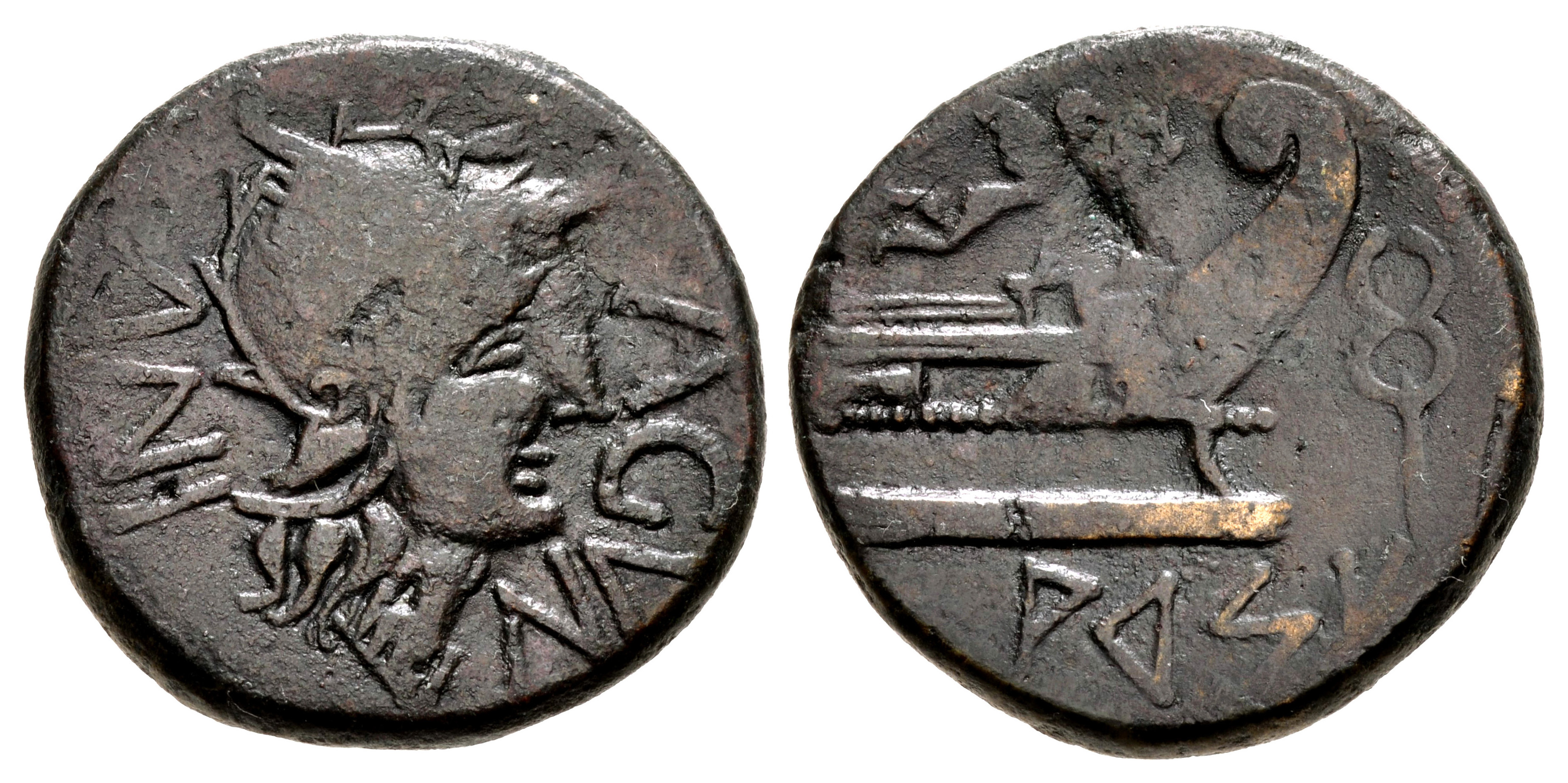S 1676 - Arse-Saguntum, bronze, asses (130-72 BCE)
From SILVER
130 BCE - 72 BCE Bronze
Description
| ObverseInscription or printing placed on the obverse.: | SAGVNTINV (Latin).Helmeted head of Roma right |
| ReverseInscription or printing placed on the reverse.: | Arse (Iberic).Prow right, above, Nike flying right, holding wreath, to right, kerykeion |
Mint and issuing power
| MintIdentifies the place of manufacture or issue of a numismatic object.: | Arse-Saguntum | Ancient regionAncient region.: | Hispania Citerior | Modern countryModern country: Spain | AuthorityIdentifies the issuing power. The authority can be "pretended" when the name or the portrait of X is on the coin but he/she was not the issuing power. It can also be "uncertain" when there is no mention of X on the coin but he/she was the issuing power according to the historical sources: | Roman Republic |
Chronology
| FromIdentifies the initial date in a range assigned in a numismatic context. | 130 BCE | toIdentifies the final date in a range assigned in a numismatic context.. | 72 BCE | PeriodTime period of the numismatic object.: Hellenistic 323-30 BC |
Physical description
| MetalThe physical material (usually metal) from which an object is made.: | Bronze |
Median weightMedian of the weights of numismatic objects (in grams). in grams | 22.00 | DenominationTerm indicating the value of a numismatic object. Examples: tetradrachm, chalkous, denarius.: | as |
StandardStandard.: |
Image

S 1676 - Arse, bronze, asses (130-72 BCE).jpg [1]
References
| Die study referencePublication of the study: | Ripollès - Llorens 20021Ripollès - Llorens 2002, p. 424-451, n° 270-332: O146-174/ R192-235 (Period III) | ||
| Coin series referenceReference to coin series study: | ACIP2ACIP, n° 1986 | ||
Obverse dies distribution
| FrequencyFrequency of specimen in distribution. ᵖ | Number of obversesNumber of obverse dies. ᵖ (o) | % (o) | Number of coinsNumber of coins. (n) | % (n) | Die nameName(s) of the die(s). |
| 1 | 3 | 10 | 3 | 0.78 | 153, 164, 168 |
| 2 | 1 | 3.33 | 2 | 0.52 | 169 |
| 3 | 2 | 6.67 | 6 | 1.57 | 170, 175 |
| 4 | 1 | 3.33 | 4 | 1.04 | 163 |
| 5 | 1 | 3.33 | 5 | 1.31 | 160 |
| 6 | 2 | 6.67 | 12 | 3.13 | 161, 167 |
| 7 | 1 | 3.33 | 7 | 1.83 | 171 |
| 8 | 1 | 3.33 | 8 | 2.09 | 147 |
| 10 | 1 | 3.33 | 10 | 2.61 | 148 |
| 12 | 1 | 3.33 | 12 | 3.13 | 173 |
| 13 | 1 | 3.33 | 13 | 3.39 | 165 |
| 14 | 2 | 6.67 | 28 | 7.31 | 150, 159 |
| 15 | 4 | 13.33 | 60 | 15.67 | 149, 151, 155, 156 |
| 16 | 1 | 3.33 | 16 | 4.18 | 157 |
| 19 | 1 | 3.33 | 19 | 4.96 | 154 |
| 20 | 2 | 6.67 | 40 | 10.44 | 162, 166 |
| 21 | 1 | 3.33 | 21 | 5.48 | 172 |
| 27 | 1 | 3.33 | 27 | 7.05 | 152 |
| 28 | 1 | 3.33 | 28 | 7.31 | 174 |
| 30 | 1 | 3.33 | 30 | 7.83 | 158 |
| 32 | 1 | 3.33 | 32 | 8.36 | 146 |
| Total | 30 of 30 | 99.96 | 383 of 383 | 99.99 |
Reverse dies distribution
no distribution is available
Quantification
| Number of obversesNumber of obverse dies. ᵖ (o) | 30 | Number of singletons (o1)The number of singleton coins. ᵖ | 3 |
| Number of reverse diesNumber of reverse dies. (r) | 46 | Number of coinsNumber of coins. (n) | 383 |
| Coins per obverse dieNumber of coins per obverse die. (n/o) | 12.77 | Coins per reverse dieNumber of coins per reverse die. (n/r) | 8.33 |
| Reverse per obverse ratioRatio of obverse dies divided by reverse dies. (r/o) | 1.53 | Percentage of singletons (o1)number of coins (n) divided by the number of singletons (o1) ᵖ | 10 % |
| Original number of dies (O) (Carter 1983 formula)The estimation of the number of coins according to Carter 1983 ᵖ | 29.91 | Coins struck if 20,000 as average productivity per dieCoins made if the average productivity for obverses (according to Carter) is 20,000. ᵖ | 598,200 |
| Original number of dies (O) (Esty 2011 formula)The estimation of the number of coins according to the singleton formula in Esty 2011 ᵖ (O) | 32.55 | Survival rate if 20,000 as average productivity per dieSurvival rate if average productivity is 20,000. ᵖ | 0.00064 |
| Coverage (o = % of O) (Esty 1984 formula)Esty 1984 - coverage (% of O) ᵖ (o = % of O) | 99.22% | Die productivity if survival rate 1/2,000Average productivity if survival rate is 1/2,000. ᵖ | 25,610.16 |
| Weight of silver (in kg) if 20,000 coins per die (O = Carter formula)Carter 1983 * Median weight * 20000 (*10 if gold or electrum) ᵖ | n.a. | Die productivity if survival rate 1/5,000Average productivity if survival rate is 1/5,000. ᵖ | 64,025.41 |
Remarks
Most likely one single workstation See charts p. 195, 197 and 200